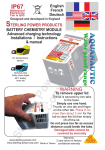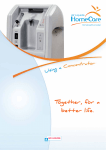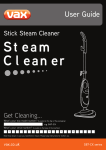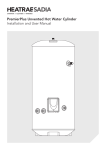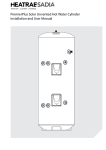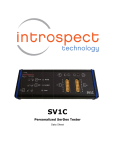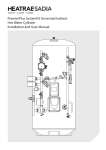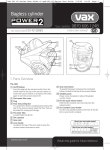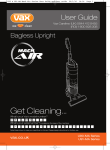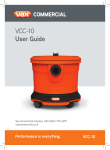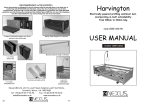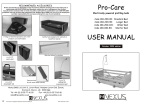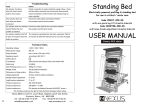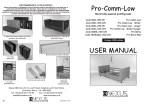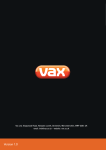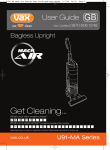Download AL0484 Home Oxygen Paediatric User Guide
Transcript
Are e W o Wh Air Liquide (Homecare) Ltd is a leading home healthcare provider in the UK. We supply a range of equipment solutions for home oxygen users to encourage activity and independence so they can lead an active and enhanced quality of life. Please read this brochure/folder and inserts so that you understand: l What equipment has been supplied to your child l How the equipment works l How to use the equipment that your child’s healthcare professional has requested, safely and effectively Together, for a better life. t r a t S u o Y e r o f e B Before you use any of your child’s oxygen equipment there are some simple and important safety rules that you must follow. If you are unsure about them after reading this, please speak to your Homecare technician a customer services co-ordinator or your healthcare professional who can explain these safety rules to you. General Safety Information Oxygen is a colourless and odourless gas so the normal human senses cannot detect if there is more oxygen than normal in the surrounding air. Oxygen makes up 21% of the air we breathe. Oxygen when combined with heat and fuel helps things to burn more easily and more fiercely. Oxygen can build up unnoticed on clothing and in hair as your child breathes. Even while they sleep and use oxygen, the bedding can become saturated. This is only a problem if there are sources of ignition such as smoking or heat sources which may cause a spark or fire. Many people use oxygen safely everyday, but you MUST follow the important safety rules. In oxygen enriched atmospheres, fabrics, wood, paper and other materials which normally do not burn easily in air may suddenly catch fire on contact with a small spark, cigarette or naked flame. Fatty substances, oils and greases may ignite in oxygen. Fire Triangle To start a fire, three things are needed: l Fuel – something to burn l Heat or a spark – something to set it alight l Oxygen – to support the fire and keep it going Higher Oxygen Concentrations may increase the Risk of Fire Oxygen can build up and become concentrated in a closed room or a confined space. Oxygen equipment should be used in a room that is well ventilated. NEVER smoke or allow others to smoke where home oxygen is being used. Home Oxygen Paediatric User Guide t n n a o i t t a r m r o o p f n Im ety I f a S Fire Risks Materials burn much faster in oxygen than in air alone. n NEVER smoke or let anyone smoke near your child while they are using oxygen equipment n NEVER use the oxygen equipment near (within three metres) open fires or naked flames n In the event of a fire leave the building immediately and ring 999 and ask for the Fire Service. Advise the Emergency Operator that there is oxygen on the premises n ALWAYS contact Air Liquide (Homecare) Ltd to tell us what oxygen equipment was involved in the fire n NEVER use any oxygen equipment that has been involved in a fire or accident Note: You are advised to plan how to evacuate the building in the event of a fire. Your local Fire Service may be able to help you do this. Storage & Use ALWAYS follow the advice given to you by your Homecare technician about the safest place to store and use your child’s oxygen equipment. n ALWAYS ensure oxygen equipment is stored in a well ventilated area, kept clean, dry and away from any sources of heat or fire e.g. convection heaters, gas or electric fires, gas cookers, etc n REMEMBER birthday candles are a naked flame – take extra care if your child is using oxygen equipment n NEVER store oxygen equipment close to paint, oil, grease or any domestic heating gases, e.g. in a garage or shed where these items may be stored n NEVER keep combustible materials near oxygen equipment e.g. newspapers, magazines, clothing, toys and other items that may burn easily n ALWAYS store cylinders either laid down flat or secured upright to prevent them from falling over – especially if you have other young children in the home n ALWAYS store the liquid oxygen base unit upright t n n a o i t t a r m r o o p f n Im ety I f a S Oxygen Saturation (Enrichment) Materials will become saturated or enriched with oxygen and may burn very quickly and fiercely if they catch fire. n ALWAYS turn off the oxygen equipment when your child is not using it n ALWAYS use or store oxygen equipment in a well ventilated area n NEVER place oxygen equipment near curtains or cover it with coats, blankets or other materials that may restrict the air circulation around it n NEVER leave the cannula or mask on the bed or chair when oxygen equipment is switched on n NEVER carry or use portable oxygen equipment under clothing or in an airtight bag (ALWAYS use the bag provided) Oils & Grease n ALWAYS make sure your hands are clean and ONLY use water based soluble creams or products similiar to K-Y Jelly when using oxygen equipment n NEVER use oils or grease with oxygen equipment n NEVER use Vaseline or other oil based creams to soothe a sore area around your child’s nose or mouth when using oxygen equipment. ONLY use water based soluble creams or products similiar to K-Y Jelly when using oxygen equipment n If using sun cream on your child, ensure it is not oil or petroleum based Home Oxygen Paediatric User Guide t n n a o i t t a r m r o o p f n Im ety I f a S Cold Burns n NEVER tamper with liquid oxygen equipment as this can cause cold burns n ALWAYS refer to the manufacturer’s operating instructions/user manual or filling guide n In the event of accidental contact with the skin l DO NOT rub l Remove any clothing if necessary and gently apply slightly warm water for at least 15 minutes l Seek medical advice Connecting the Tubing Connecting the tubing to your child’s oxygen supply system is simple and the Homecare technician will show you how this is done when they install the oxygen equipment. n NEVER use tubing over 15 metres (approximately 50 feet) long as this will reduce the flow n Take care with any tubing lying on the floor and make sure it is not trapped under doors, cots, high chairs and heavy items of furniture and that it is not kinked n Take care not to trip over any tubing lying on the floor t n n a o i t t a r m r o o p f n Im ety I f a S Flow Rate - Litre Per Minute (l/min) Your child’s flow rate has been requested by their healthcare professional and it must not be changed without asking them first. If your child needs a variable oxygen flow rate, their healthcare professional will tell you when to alter the flow. n NEVER set the oxygen flow rate to anything other than that requested by your child’s healthcare professional n Before opening the flow valve, make sure that the flow rate indicator is set to zero n If your child needs low flow oxygen, ensure the low flow regulator is attached to the cylinder n Open the valve slowly by turning it anti-clockwise and then set the flow meter or low flow regulator at the flow rate indicated by your child’s healthcare professional n You can check for a flow by removing the cannula, setting it aside and placing the end of the tube in a glass of water, watching for bubbles. Alternatively, hold the end of the cannula over the back of your hand or near your eye to feel lower flows of oxygen n NEVER place the end of the cannula in the water Home Oxygen Supply n ALWAYS close the valve on the oxygen cylinder when your child is not using it n Regularly check that there is adequate supply of oxygen by checking the contents gauge on the cylinder and the liquid oxygen base unit n NEVER allow the oxygen cylinder or base unit to completely empty – check the contents gauge regularly n Liquid oxygen will evaporate when not in use, but this happens very slowly from the base unit and you should not run out if you check the contents gauge daily Home Oxygen Paediatric User Guide nt e m p i u q E g n i n i a t in a M Cleaning n To clean concentrators and cylinders use only a clean damp cloth n To clean liquid oxygen systems use only a clean dry cloth n Use only mild non-abrasive cleaning materials n After wiping equipment down, allow it to dry before use Repairs n Should the oxygen equipment fail for any reason, connect your child’s cannula to the back up cylinder and call the 24/7 Customer Helpline n NEVER attempt to repair or modify any fault n NEVER attempt to modify the home oxygen installation n NEVER attach any accessories not supplied by Air Liquide (Homecare) Ltd s e l b a m u s n o C Taking Care of Your Child’s Cannula or Mask Your child has been supplied with consumables for delivery of their oxygen therapy – these consumables are requested by your child’s healthcare professional. ALWAYS use the consumables supplied by Air Liquide (Homecare) Ltd. To fit your child’s nasal cannula: l Carefully place the prongs of the cannula into your child’s nostrils l Tuck the tubes of the cannula behind your child’s ears l Secure with the toggle at the back of the head l Older children will need to secure the toggle under the chin Your child’s cannula can easily become blocked by nasal secretions and mucus, especially if they have a cold. Both cannula and masks should be kept as clean as possible. 1. Regularly change the nasal cannula – every month or more frequently if necessary 2. Over time nasal cannula will become brittle if not changed and may cause nasal irritation and discomfort 3. NEVER attempt to wash out the cannula as it will be difficult to dry thoroughly 4. Ensure masks are wiped clean regularly and are discarded as soon as they show signs of wear 5. Check the cannula and mask tubing regularly for signs of damage such as splits or kinking 6. You may wish to keep a note of the cannula size or product number so you can easily re-order Home Oxygen Paediatric User Guide e n m e o g H y Ox pment at i u q E In your Home Discuss with the Homecare technician the rooms in which your child will need access to oxygen. This way the Homecare technician will know how much tubing to leave to allow you to move around your home. 1. The easiest way to transfer your child to another oxygen cylinder is to disconnect the flow meter and re-connect to the new cylinder with cannula still attached. 2. As you move around your home ensure tubing does not become trapped under doors, cots or heavy furniture. 3. When bathing your child, prevent water from getting inside the cannula as this may restrict the oxygen flow. 4. You must speak to your child’s healthcare professional if you would like to take them off oxygen for short periods of time for moving around the home or bathing etc. t u o b A d n a t u O Getting Out and About Your child’s healthcare professional may have ordered portable oxygen supplies if required for your child. It is important that you and your child get used to being out and about with oxygen. 1. Before you leave the house, check your cylinder or liquid portable unit has plenty of oxygen for the trip you are planning (refer to the technical specification sheet for durations). 2. ALWAYS pack a replacement cannula or mask in case needed when out. 3. If taking a cylinder out on your child’s pushchair, ensure it is located as low as possible so it is less likely to fall. 4. Discuss with the Homecare technician the best way to transport a liquid oxygen unit on your child’s pushchair. 5. Always transport liquid oxygen units upright. When in a car, either hang the portable liquid oxygen unit over the back of a car seat or secure it in a footwell to ensure it is upright. 6. Liquid oxygen will evaporate more quickly the more the unit moves around – where possible ensure it is stable. Home Oxygen Paediatric User Guide Nursery and School If oxygen is required in your child’s nursery or school, please speak to your child’s healthcare professional. Many children who use oxygen attend a nursery or school and usually we do not encounter any problems with setting up the supply. Talk to your healthcare professional about the option of setting up a secondary supply at your child’s nursery or school so that oxygen can be supplied on a permanent basis. We have Respiratory Nurse Advisors and our Homecare technicians who can visit the nursery or school to help train the staff and answer their questions if they are unfamiliar with oxygen equipment. Please call our 24/7 Customer Helpline for more information. Activities Oxygen should not stop your child from joining in most everyday activities but you should check with your child’s healthcare professional if it is safe for your child to do so. If they agree, we can help with advice. u o y o t r u O mitment m o C Taking care of you every step of the way: Air Liquide (Homecare) Ltd is a leading home healthcare provider committed to supporting your child whilst they are using home oxygen. We understand that you and your family may be unsure about the new equipment that has been selected by your child’s healthcare professional, but our team is here to help you with advice, training and support. Our Team If you are new to the service, you will be supported by a dedicated team of professionals led by a respiratory nurse – until you are happy with the equipment and service that you and your child are receiving. For ongoing support, our trained Customer Service team is available 24 hours a day, 7 days a week, to answer any questions you may have. Our team of Homecare technicians are trained to install and maintain equipment and will explain how the equipment works. Servicing and Maintenance Whilst the equipment supplied by Air Liquide (Homecare) Ltd remains our property, we will need access to the equipment for routine maintenance. All maintenance arrangements will be made on a day and a time that is convenient to you. Together, for a better life. Home Oxygen Paediatric User Guide Home Oxygen Paediatric User Guide X0919000 - 07 2013 Air Liquide (Homecare) Ltd Alpha House, Wassage Way, Hampton Lovett, Droitwich, WR9 0NX.
















